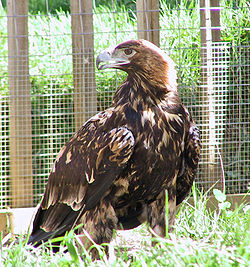La Mancha
It is a fertile plateau (610 m or 2000 ft) that stretches from the mountains of Toledo to the western spurs of the Cuenca hills, bordered to the south by the Sierra Morena and to the north by the Alcarria.
Another etymology ascribes the origin of La Mancha to المانيا al-manya, which is an Arabic expression for "elevated plain" or "high plateau".
Unless the scarce or "patchy" vegetation cover is considered, no apparent link exists between the Spanish false cognate mancha and the name of the region.
Farming (wheat, barley, oats, sugar beets, wine grapes, olives) and cattle raising are the primary economic activities, but they are severely restricted by the harsh environmental conditions.
Viticulture is important in Tomelloso, Alcázar de San Juan, Socuéllamos, Valdepeñas, La Solana and Manzanares, in Ciudad Real and Villarrobledo in Albacete.
[4] Translator John Ormsby believed that Cervantes chose it because it was the most ordinary, prosaic, anti-romantic, and therefore unlikely place from which a chivalrous, romantic hero could originate, making Quixote seem even more absurd.




